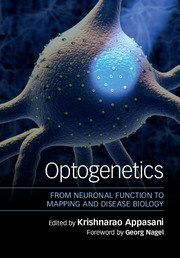Book contents
- OptogeneticsFrom Neuronal Function to Mapping and Disease Biology
- Optogenetics
- Copyright page
- Dedication
- Contents
- Contributors
- Foreword
- Preface
- Part I Optogenetics in Model Organisms
- Part II Opsin Biology, Tools, and Technology Platform
- Part III Optogenetics in Neurobiology, Brain Circuits, and Plasticity
- Part IV Optogenetics in Learning, Neuropsychiatric Diseases, and Behavior
- Part V Optogenetics in Vision Restoration and Memory
- 22 Optogenetics in Treating Retinal Disease
- 23 Optogenetics for Vision Recovery: From Traditional to Designer Optogenetic Tools
- 24 A Promise of Vision Restoration
- 25 Holographic Optical Neural Interfacing with Retinal Neurons
- 26 Strategies for Restoring Vision by Transducing a Channelrhodopsin Gene into Retinal Ganglion Cells
- 27 Optogenetic Dissection of a Top-down Prefrontal to Hippocampus Memory Circuit
- Part VI Optogenetics in Sleep, Prosthetics, and Epigenetics of Neurodegenerative Diseases
- Index
- Plate Section (PDF Only)
- References
26 - Strategies for Restoring Vision by Transducing a Channelrhodopsin Gene into Retinal Ganglion Cells
from Part V - Optogenetics in Vision Restoration and Memory
Published online by Cambridge University Press: 28 April 2017
- OptogeneticsFrom Neuronal Function to Mapping and Disease Biology
- Optogenetics
- Copyright page
- Dedication
- Contents
- Contributors
- Foreword
- Preface
- Part I Optogenetics in Model Organisms
- Part II Opsin Biology, Tools, and Technology Platform
- Part III Optogenetics in Neurobiology, Brain Circuits, and Plasticity
- Part IV Optogenetics in Learning, Neuropsychiatric Diseases, and Behavior
- Part V Optogenetics in Vision Restoration and Memory
- 22 Optogenetics in Treating Retinal Disease
- 23 Optogenetics for Vision Recovery: From Traditional to Designer Optogenetic Tools
- 24 A Promise of Vision Restoration
- 25 Holographic Optical Neural Interfacing with Retinal Neurons
- 26 Strategies for Restoring Vision by Transducing a Channelrhodopsin Gene into Retinal Ganglion Cells
- 27 Optogenetic Dissection of a Top-down Prefrontal to Hippocampus Memory Circuit
- Part VI Optogenetics in Sleep, Prosthetics, and Epigenetics of Neurodegenerative Diseases
- Index
- Plate Section (PDF Only)
- References
- Type
- Chapter
- Information
- OptogeneticsFrom Neuronal Function to Mapping and Disease Biology, pp. 382 - 392Publisher: Cambridge University PressPrint publication year: 2017



